What is surprising to me is how and why the US has never considered a destroyer design apart from Zumwalt. Seems very shortsighted.
Current CG/DDG/FFG typology is the result of reclassification of USN vessels in 1975:
- CG is a large ship with command facilities, with anti-air weapons and capable of two sea control tasks simultaneously (anti-air/anti-surface)
- DDG is a large ship without command facilities, with anti-air or anti-submarine weapons and capable of two sea control tasks simultaneously (anti-air/anti-surface or anti-submarine/anti-surface)
- FFG is a small ship without command facilities, with anti-air or anti-submarine weapons and capable of one sea control task.
In the late 1980s CNO ordered a series of studies to develop a different fleet and ship design utilizing new technologies - electric drive, lasers, vertical launchers, distributed and networked sensors and C2 - to optimize the force for fighting Soviets in East Atlantic. The results of the studies were presented as part of the Surface Combatant for 21st Century (SC-21) program which to a large extent did away with the old typology introducing new class concepts like "arsenal ship". This program went nowhere after 1992 when Cold War ended and radical cuts were introduced.
To develop technology and capability SC-21 was changed to DD-21 which was a destroyer in name only, since its purpose was to replace Iowa battleships as part of Naval Fire Support program. Zumwalt was therefore a land attack ship which served as an excuse to fund technologies and architecture described in the SC-21 studies. It's a "destroyer" because that's how budget documents described it. It doesn't make sense at first sight because it wasn't supposed to make sense. It was supposed to get the money going and as such it is a moderately successful R&D program that produced an unsuccessful "destroyer".
USN didn't develop a new destroyer because it didn't need one. In terms of the 1975 typology USN consistently expressed its need for cruisers and frigates - not destroyers - and optimally for introduction of SC-21. This is where the "payloads not platforms" or "distributed warfighting" concepts come from as well as most of the "new" solutions like lasers or IED - with the exception of unmanned systems which are a recent development.
Burkes are components of a carrier strike group. Since the primary purpose of helos is to provide situational awareness for the ships it isn’t much of a problem since the carriers could handle that easily.
Flight I (DDG-51 to 71) and Flight II (DDG-72 to 78) replaced Charles F Adams and Farragut classes od DDGs which were anti-air destroyers serving as escorts, neither of which carried helos. The landing pad is primarily used for ASW helos from carrier wing and it is technically an improvement in capability over its predecessor.
Flight IIA ( DDG-79 to 112) replaced Spruance DDGs so the primary role of the helos is organic ASW
Compare:
Charles F Adams
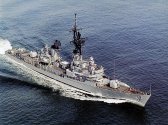
Farragut
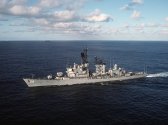
Spruance
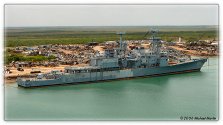
Similarities to Flight I,II and IIA should be visible.
Burkes were criticized a lot when they were designed and built (they were originally a reaction to the inability to create enough aegis cruisers) and weren't really supposed to become the core of the navy. The situation has changed in 1991, for obvious reasons - and they suddenly became super attractive, and proliferated accordingly.
In the 1970s ONI and CIA misread the developments of Soviet navy and assumed that USSR would aggressively combat USN in the North Atlantic - first with submarines and long-range aviation using cruise missiles, and ultimately their own carrier battle-groups. This led to the development of "high-low mix" concept where the core of fleet would be composed of "high"-ly capable cruisers (AAW) and destroyers (ASW) while regular escort missions would be left to "low"-end frigates and "sea control ships" (light carriers of Spanish Principe de Asturias type). All "high" ships would share the AEGIS system to combat aerial threats but cruisers were supposed to be nuclear - following the decision to establish nuclear-only carrier and submarine force.
Ticonderoga-class cruiser was originally an ASW destroyer with AEGIS built using Spruance-class hull and propulsion. The production of CG-47 starts along with the production of DDG-997 (the last Spruance) in 1980. The first five Ticos have Mk.26 and because Mk.41 wasn't ready at the time and with the exception of AEGIS are very similar to the Kidd-class originally intended for Iran. The AEGIS cruiser was supposed to be the CGN-42 - the fifth and cancelled Virginia-class CGN.
For economic and political reasons the plans were changed and Ticonderoga destroyers were reclassified as cruisers which meant that the actual destroyers - Arleigh Burke-class - were almost identical to new cruisers which is where the confusion comes from including "Burkes are practically cruisers". Oh the irony...
As I said earlier Burkes weren't random ships but were direct replacement of classes in service and the differences between Flights I, II and IIA reflect that. Planned production of Burkes ended in 2012 with the commissioning of DDG-112. The problem did not lie with the destroyers but with the rest of the fleet.
Right now equation is starting(just starting) to change - but by now they have decades of being almost flawless in their role. This is remarkable.
The equation changed in 2008-2011 but the relevant decisions were taken in 2001-2008 during the George W. Bush administration. After 2008 it was just trying to prevent the fleet from sinking.
In 1991 the USN had 99 frigates - 46 Knox-class and 53 OHP-class. All 46 Konxes and 12 short-hull OHPs were withdrawn by 1996, the remaining 10 short-hull OHPs by 2003 and 31 long-hull OHPs were serving as patrol vessels without upgrades until 2011-2015. In the meantime they were replaced by LCS which didn't enter service in time and was reduced from original 55 to 35. The first Constellation-class (FREMM) is scheduled to enter service in 2026 after a decade of no equivalent in service which will slow down the introduction of the class even if the production of 20 ships by 2030 is not delayed.
If instead of politically-conceived LCS the Navy got new frigates then by 2030 USN would have as many as 60 capable and mature ships with working logistics. Possibly more than that since there would be no pressure to produce more Flight IITI and III Burkes to relieve older ships - as Flight I and II Burkes do missions that should be done by modern FFGs.
The problem lay in the weakness of OHP class which was a badly designed outdated ship - especially compared to European modular frigates from the 90s. If USN had a working frigate design then LCS would have never taken off (just look at A-10!) but OHP was an example of how not to design ships so LCS had no competitor.
Wow apparently the Arleigh Burke design is not really as impressive as I thought
Just found out that 27 out of 68 of them (Flight I and II) cannot carry helicopters, while the later ones (IIA) that can carry helos don't have harpoons or towed array sonar
Meanwhile the Flight III looks decent but not really ideal considering a stretched 30 yo non-stealth hull is going to be the backbone of the US navy for the next 30 years (and also replacing Tico-cruisers)
Flight IIA was not originally fitted with AN/SQR-19 but that was later changed and now all ships are being refitted with AN/SQR-20.
Flight III is not really decent. It is running at maximum capacity of outdated ship architecture. Consider that first Flight III enters service in 2023 which with 35-year life means service until 2058 for a ship with architecture (and thus potential for upgrades) from 1991. That's 67 years.
Consider that a WW2 destroyer from 1945 was only 46 years old in 1991. This is how outdated Arleigh Burke Flight III class is regardless of new radars or computers. There are serious consequences to that - especially logistics - that are not obvious at first glance.
Or we can think about it this way - is M4 Sherman with a laser a future tank?




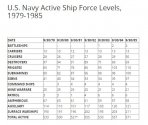
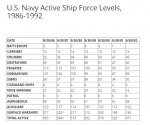
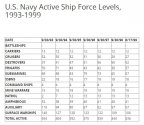
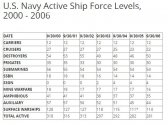
:quality(70)/cloudfront-us-east-1.images.arcpublishing.com/mco/4KYJ4Y2DFREDXB4GMRNE52UCZU.png)